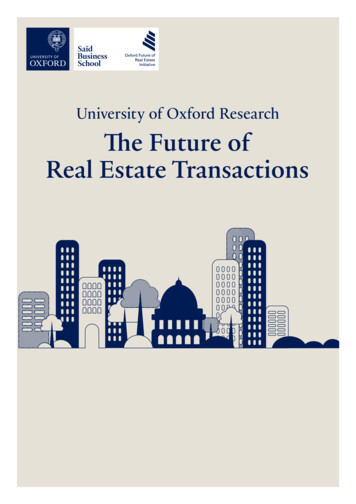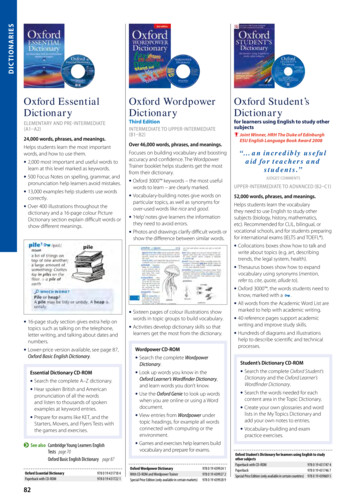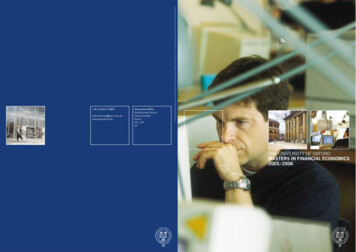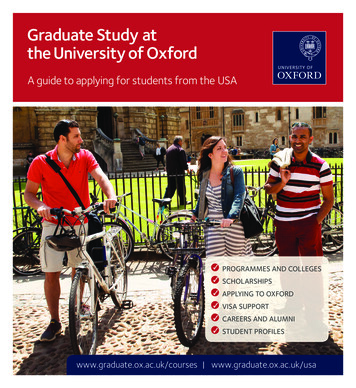
Transcription
1RESPO NSI BLE BUSI NESS F O RU M – T H E E C O N O MI C S O F MUT UA L IT YTitle of pageUniversity of Oxford ResearchThe Future ofReal Estate Transactions
FUTURE OF REAL ESTATE INITIATIVETHE FUTURE OF REAL ESTATE TRANSACTIONS:Technology, innovation and the real estate conveyancing process“If you always do what you always did, you will always get what you always got.” (Anon)For many, this quotation could be fairly adopted as a criticism of a technology-averse and outdatedreal estate transaction process in England and Wales.This report seeks to provide an objective view of the short to medium term potential for change. Wehighlight inefficiencies within the current transaction and conveyancing processes in England andWales, we examine the reforms that are possible given recent and upcoming technological and socialtransformations, and we identify the blockages that are most – and least – likely to be overcomethrough digital innovation.Source: New Statesman, 2018THE FUTURE OF REAL ESTATE TRANSACTIONSWWW.SBS.OXFORD.EDU1
FUTURE OF REAL ESTATE INITIATIVEThis report has been compiled with the assistance of Bryan Cave Leighton Paisner, CBRE and HerMajesty’s Land Registry. We are sincerely grateful for their expert support and would like to thank allwho have contributed to this report. We would like to clarify that any stated opinions, and anyremaining errors, are our own.We are grateful to our partners in the Oxford Future of Real Estate Initiative (Arcadis, Bryan CaveLeighton Paisner, CBRE, The Crown Estate, EY, Nuveen Real Estate, Redevco, and UBS) for theirfinancial support.The Oxford Future of Real Estate Initiative at the Saïd Business School is led by Professor AndrewBaum and is a collaboration between Oxford academics and industry-leading organisations that aimsto advance knowledge in real estate. Our research is grounded in real-world business questions.Further information on the research initiative can be found -real-estate-initiative.Any reference to specific companies or organisations does not constitute a recommendation and isincluded solely for illustrative or case study purposes.We welcome reader feedback and comments, which can be sent to us via e-mail at:realestate.reports@sbs.ox.ac.ukAndrew Saull and Andrew BaumSaïd Business SchoolMarch 2019THE FUTURE OF REAL ESTATE TRANSACTIONSWWW.SBS.OXFORD.EDU2
FUTURE OF REAL ESTATE INITIATIVEContents1.Introduction . 52.Conveyancing and registration processes . 72.1Introduction . 72.2The England and Wales conveyancing process. 82.2.1Digitising the conveyancing process . 122.2.2Current technology: data rooms and cloud computing . 152.3England and Wales land registration . 152.3.13.Real estate transactions today . 183.1Introduction . 183.2Causes for delay within the England and Wales conveyancing process: a process map . 193.2.14.Digitising Her Majesty’s Land Registry . 17Analysis of the causes for delay . 28The future of real estate transactions . 304.1Introduction . 304.2Digitalising the transaction process . 304.2.1Satellites and drones . 304.2.2Blockchain transactions: smart contracts . 314.2.3Property passports: IoT and BIM . 364.2.4Artificial intelligence and machine learning: lease information extraction, AVMs andinstant mortgages, VR/AR . 414.2.5Digitalising land registration: chatbots . 454.2.6Blockchain land registration . 484.2.7Analysis of applicable technologies . 524.34.3.1Operational barriers . 534.3.2Regulatory barriers . 574.3.3Social barriers. 604.3.4Analysis of technology adoption . 644.45.Barriers to the adoption of technology. 52The drivers of change . 65Summary and conclusions . 675.1Summary . 675.2Conclusions . 68Acknowledgements. 71THE FUTURE OF REAL ESTATE TRANSACTIONSWWW.SBS.OXFORD.EDU3
FUTURE OF REAL ESTATE INITIATIVEReferences . 72Appendix 1: an example of an HMLR title document . 83Appendix 2: international conveyancing comparisons . 85Appendix 3: the commercial transaction process using corporate structures and debt . 88Appendix 4: international land registration comparisons . 89Appendix 5: a brief history of the English and Welsh land title system . 93THE FUTURE OF REAL ESTATE TRANSACTIONSWWW.SBS.OXFORD.EDU4
FUTURE OF REAL ESTATE INITIATIVE1. IntroductionLand shelters us, feeds us, and provides us with space for recreation, for shopping, and for work.With total global real assets valued at US 238tn (Savills, 2017), land as an investment is a significantcomponent of the global economy, accounting for between half and three-quarters of each individualeconomy’s wealth (World Bank, 2004). How we as a society transfer ownership of this vital commodityis a matter of political and economic consequence. This report investigates how technology can helpmake this process faster and less expensive.This report is primarily concerned with the institutional commercial real estate investment market.While the legal principles involved in residential and commercial property transactions are the same,the scale and level of risk are quite different, and the process is less commoditised.A commercial land transaction broadly consists of five clear processes involving a host of actors.Sellers and their agents are responsible for the preparation period and the marketing period requiredto establish an asking price and negotiate a deal. One set of solicitors acting for the buyer and anotherfor the seller are then responsible for the conveyance, which is the administrative process by whichrights over land are created and transferred, with funds moving in the opposite direction. This includesall necessary legal works during the due diligence period and post-exchange period. Finally, a landregistry must collect land taxes and record the legal ownership during the post-completion period.The transaction process is then complete.In Chapter 2, we briefly look at the legal foundations of this process, primarily as it works in Englandand Wales, and examine the legislative developments that have taken place to facilitate itstransformation from its origins as a paper based, or analogue, system. We identify the areas ofinefficiency in the current process before examining historical attempts to streamline conveyancingand land registration through the use of technology.Advances in computer performance, capacity and connectivity have created new ‘digitised’ methodsof transacting real estate, currently prevalent in commercial conveyancing. Digitisation is the meansthrough which we convert paper hard copies into unintelligent digital soft copies; data held withindigitised documents are unable to be extracted through computer programmes and require humaninterpretation. In practice, digitisation can be thought of as scanning a page, uploading a photo, orcreating a pdf, so as to have a digital copy of an original document.By contrast, ‘digitalisation’ is the act of converting anything into a digitally readable format. Digitaliseddata enable computer programmes to automatically execute tasks without the need for humanintervention. In practice, this means completing forms online to enable software processes to act uponthe machine-readable, ‘intelligent’ information.While many Proptech companies currently offer digitalised platforms which could streamline theproperty transaction process, the real estate industry is slow at adopting these new technologies, andit is arguable that the most significant transformation yet to take place is the normalisation ofTHE FUTURE OF REAL ESTATE TRANSACTIONSWWW.SBS.OXFORD.EDU5
FUTURE OF REAL ESTATE INITIATIVEtechnologies which automate current manual procedures. For this to occur, a step beyond digitisationmust prevail and the data upon which the industry runs must be digitalised.Chapter 3 uses a case study and a focus group to map the conveyancing process used in Englandand Wales. Through this process we examine the current use of digitised technologies and outlinethe key causes for delay within a commercial property conveyance.In Chapter 4, we focus on the extent to which emerging digitalised technologies could solve thesecauses of delay and speed the broader property transaction process. These include blockchain andsmart contracts, artificial intelligence and lease extraction technologies, machine learning andautomated valuation models, the internet of things and property passports, virtual reality and satellitetechnologies. While we focus on commercial transactions, we also draw on the experience of the highstreet conveyancing firms and residential markets to explore common issues.By conducting interviews with various Proptech start-ups and technology experts within majorcommercial real estate companies, we explore the barriers to adoption which exist for these emergingtechnologies and begin to highlight some of the pre-requisites needed before any real ‘disruption’ tothe current process of a transaction can occur.We conclude in Chapter 5 with a summary of our findings.THE FUTURE OF REAL ESTATE TRANSACTIONSWWW.SBS.OXFORD.EDU6
FUTURE OF REAL ESTATE INITIATIVE2. Conveyancing and registration processes2.1IntroductionMany economists and philosophers have expressed concern about the private ownership of land(Ryan-Collins et al, 2017). However, for those fortunate enough to be landowners it is vital to be ableto prove land title. Land title provides financial protection, a store of value and a potential source ofdebt finance. If secure title is guaranteed by a reliable land registration system, land can be used tocreate wealth for the broader benefit of society and contribute to the eradication of poverty (WorldBank, 2004). Insecure title to land prevents people from taking full advantage of its productive capacityand limits economic growth.Land is a unique commodity: it is indestructible and immoveable, and it is possible for many peopleand the public to have a multiplicity of interests over the same piece of land. Examples of public rightsare those imposed by planning systems. Claimants of private rights over any piece of land can include:-the freeholder(s) owns the plot of land in perpetuitythe lender(s) finances a purchase and receives part of the ownership rightsthe leaseholder(s) leases the plot of land from the freeholder for a long-term interestthe tenant(s) rents parts, or the full plot, of land from the freeholder, usually for a short-terminterestspouses have occupation rights granted through family lawadjoining neighbours may possess an easement such as the right to sunlight or a right of waythrough part of the land (this can also be held by the freeholder over their neighbours)third party organisations have holding rights including:- covenants: restrictions placed upon the land use- mines and minerals: ownership of any natural resource found beneath the Earth’s surface- chancel repairs: the local church may have a right to charge locals for any maintenanceThis very simplified account of the rights and liabilities which might affect a piece of land illustrateshow necessary a robust land title is for its trustworthy transfer. An example of the potential complexityof the rights and restrictions attached to title is shown in Appendix 1.Conveyancing is the practical application of land law, the business of creating and transferring rightsin land. The relevant law is that of England and Wales, which does not apply in other parts of theUnited Kingdom. However, English imperialism has left its legacy and many other parts of the worlduse a similar common law system, including large parts of Africa as well as Australia, the US, Canadaand the Caribbean.A transparent and digital land registry, in which all land-related information is publicly available, allprocedures and property transactions are clear, and information on fees for public services is easy toaccess, eliminates asymmetrical information between users and officials with respect to servicesprovided by the land administration, thereby reducing disputes and increasing the efficiency of thereal estate market (World Bank, 2018).THE FUTURE OF REAL ESTATE TRANSACTIONSWWW.SBS.OXFORD.EDU7
FUTURE OF REAL ESTATE INITIATIVEHer Majesty’s Land Registry (HMLR) is responsible for recording the mapping and legal ownership inEngland and Wales in order to establish the legitimacy of any such interests. While the UK marketbenefits from being first in Jones Lang LaSalle’s 2018 Global Real Estate Transparency Index (JonesLang LaSalle, 2018), its digital registration process is currently ranked 47th out of 190 globaleconomies on the 2018 World Bank’s Ease of Registering Property Index (World Bank, 2018). (Itshould be noted that both of these metrics fail to separate out the processes in Scotland, NorthernIreland and the Channel Islands from England and Wales and thus may be skewed accordingly).In this chapter we will outline the main components of the current England and Wales conveyancingand registration processes and identify delays in the transaction process identified by previousstudies.2.2The England and Wales conveyancing processThe success of a property transfer can be measured by how closely the conveyancing processconforms to initial expectations, and the most important determinant of a successful property transferis probably whether settlement occurs at its intended time. Expectations may be unrealistic, orintended time periods may be over-optimistic, but there is little doubt that delays (over-runs intransaction times beyond expectations) are a common feature of the current paper-based systemswhich operate around the world. In the UK, a report by The New Statesman (2018) found that delaysoccurred in close to 40% of all transactions surveyed.Conveyancing in England and Wales is a ‘reserved activity’ under Section 12 of the Legal ServicesAct 2007. This means that it may only be carried out by authorised parties: solicitors, legal executives,or licenced conveyancers. In the institutional market, real estate deals are overwhelming brokered byinvestment surveyors from a handful of established firms. Indeed, with some institutional deals, thereis never a public advertising process. Deals are brokered and concluded behind closed doors.As most consumer/buyers must borrow money to purchase their home, the process is dominated bywhat their lenders want or are prepared to accept. Ninety percent of residential mortgages are carriedout by members of the residential mortgage lenders’ trade association, UK Finance. UK Financeproduces a handbook of what lenders expect conveyancers to do. It is usual for the buyer’sconveyancer to also act for the mortgagee (lender), although if a conflict arises the conveyancer muststop acting for both.Traditionally, conveyancing was carried out by the parties’ local solicitors. The liberalisation of theconveyancing to include ‘conveyancers’ (non-lawyers who had conveyancing qualifications and werethe member of the Chartered Institute of Licenced Conveyancers) opened up the market. However,it was the internet that drove down the price of residential conveyancing: suddenly, non-local lawyerswith lower overheads were able to undertake a conveyance for lower fees. Any online search willbring up a plethora of online conveyancers offering to work more quickly and cheaply.THE FUTURE OF REAL ESTATE TRANSACTIONSWWW.SBS.OXFORD.EDU8
FUTURE OF REAL ESTATE INITIATIVE1Figure 1: The UK commercial conveyancing processSource: Investment Property Forum, 20121There appears to be an error in the original diagram. It is the buyer, not the seller, who prepares requisitions on title,while the seller prepares replies to requisitions on title.THE FUTURE OF REAL ESTATE TRANSACTIONSWWW.SBS.OXFORD.EDU9
FUTURE OF REAL ESTATE INITIATIVEAnother factor in the commoditisation of residential conveyancing was the streamlining andstandardisation of the conveyancing process driven by such works as the Encyclopaedia of Formsand Precedents and online sources such as Lexis Nexis and Practical Law.Standardisation of documentation and process is a necessary pre-cursor to computerisation, and TheLaw Society’s conveyancing protocol for residential transactions is very widely used. The protocolmust be used by anyone who is acting for a member of UK Finance, covering an overwhelmingmajority of conveyances. The protocol identifies at least 150 separate steps in the process, dependingon whether a conveyancer is acting for seller, or buyer and lender, and whether the property isfreehold or leasehold. The process allows the simpler tasks to be done by machine or by less qualifiedstaff under the supervision of an appropriately qualified lawyer.The basic processes of conveyancing in residential and commercial work are the same. However, ininstitutional (larger commercial) transactions - a shopping centre sale, say - the subject property willalmost always be tenanted; and the building might have a complicated ownership with freeholder,leaseholder and numerous tenants, and rights over common parts. We focus particularly on theselarger transactions.International conveyancing systems are briefly explored in Appendix 2.Areas of inefficiency within the UK transaction processMcNamara (1998) identified the four periods needed for a successful property transaction. These arethe preparation period; the marketing period; the due diligence period; and the settlement (or postexchange) period. Critically, this study identified that, across all property types, the marketing phaseof a property took the most time, followed by due diligence requirements. For a detailed descriptionof the tasks to be performed within the due diligence and post-completion periods see Figure 1.An empirical attempt to quantify the time taken for each of McNamara’s four transaction periods wasundertaken by Crosby and McAllister (2004). They did so through obtaining data for over 187properties from three commercial property companies.Figure 2 charts the overall transaction times recorded for the sampled commercial properties. Thedata allows a measure of the time from the first record of the proposed sale, which often coincideswith the date the agent was instructed, to the completion of the purchase. The average transactiontime for the 184 transactions where this information was recorded is 298 days, over 9 months.However, this average is skewed by a small number of very long transactions: the median transactiontime is 190 days, or just over 6 months.The longest process is the negotiation period, measured as the time from the first record of theproposed sale to the agreement of price. The average time is 178 days, but again this is heavilyskewed, and the median is 88 days, nearly 3 months. This is consistent with McNamara’s findings ofTHE FUTURE OF REAL ESTATE TRANSACTIONSWWW.SBS.OXFORD.EDU10
FUTURE OF REAL ESTATE INITIATIVEwhat he dubbed the marketing period as being the longest process for any transaction. The duediligence process, identified as the time between sale agreed and contract exchange, averages 83days with a lower and less heavily skewed median of 62 days or 2 months, while the post-exchangeperiod averages 19 days or nearly 3 weeks.Figure 2: Overall transaction time (days)Source: Crosby and McAllister, 2004They also discovered that that the value of the property has very little effect on how long it takes tosell. The relationship between price and total transaction time is not significantly different from zero.Of equal interest is the fact that the various components of the process are not correlated: a longmarketing period is not followed by a long due diligence or completion period.This study further explored the delays in the transaction process, characterising them as either‘events’ or ‘discoveries’. An event was a human-initiated problem, for example tenant failure, while adiscovery was a step in the transaction process that was out of participant control, such as unknownasset defects or individual financing issues. These delays were found to occur most often in the duediligence stage of a transaction, with the four main influences identified as:-Previously unknown or ignored inherent problemsChanges in the asset e.g. tenant defaultChange in market conditionsChanges in the circumstances of the purchaser, for example difficulty in obtaining debt financeThe use of debt was found to result in an additional due diligence process which could cause a majordelay or a re-assessment of the offer price. For an overview of how a commercial transaction processalters through the use of corporate structures and debt, see Appendix 3.The main conclusion drawn from this study was that a number of factors may cause delays in thesales process highlighted by Figure 3. Temporary, solvable problems include title problems, tenantdisputes and outstanding rent reviews, issues that, if unresolved, would lead to a price well belowmarket value perceptions. Other factors may be intractable but temporary: these include rent reviewsand lease terminations.THE FUTURE OF REAL ESTATE TRANSACTIONSWWW.SBS.OXFORD.EDU11
FUTURE OF REAL ESTATE INITIATIVEFigure 3: Summary of findings from Crosby and McAllister (2004)2.2.1 Digitising the conveyancing processThose close to the process suggest that the real estate conveyancing world has experienced morechanges during the past 15 years than in the prior 300 years. The pressure for change is nowconstant. Real estate conveyancing is going through a major change brought on by a new electronicworld (Gose, 2008), and numerous changes in both technology and culture are putting pressure onthe conveyance process to change. Greater interconnectivity brought about by advances intechnology has made the reliance on paper seem outdated. Dictated by societal preferences anddemand, technology is reshaping conveyancing processes globally (Doversberger, 2010).The establishment of a single system connecting all the agencies that supply information involved inproperty transfers can ease the conveyancing burden for firms or individuals. This single portal systemis what is generally known as ‘e-conveyancing’, where all documents needed for a transaction areaccessible to parties in a transaction through a single online platform.The following three case studies, while residentially focused, will identify numerous issues with theestablishment of any single conveyancing portal, highlighting factors often overlooked whenadvocating the adoption of fully functioning, innovative technology solutions.Chain Matrix: an HMLR pilot scheme, 2008In 2001, with internet-based technology newly available, the Law Commission published LandRegistration for the Twenty First Century (Law Commission, 2001). This report sets out preliminaryproposals to facilitate the implementation of e-conveyancing. The resulting legislative changes in theLand Registration Act 2002 came into force on 13th October 2003.At the time, Law Commission believed that: “within a comparatively short time, electronicconveyancing will be the only method of conducting registered conveyancing. Investigation of title willTHE FUTURE OF REAL ESTATE TRANSACTIONSWWW.SBS.OXFORD.EDU12
FUTURE OF REAL ESTATE INITIATIVEbe almost entirely online. The technology will also provide a means of managing a chain oftransactions by monitoring them electronically. This will enable the cause of delays in any chain to beidentified and remedial action encouraged. It is anticipated that far fewer chains will break inconsequence and that transactions will be considerably expedited” (Law Society, 2017a).HMLR set about piloting its own e-conveyancing platform called Chain Matrix in Autumn 2006. Thesystem would allow buyers, sellers, their legal representatives, estate agents and lenders to view theprogress of every transaction in a property chain, thus highlighting where a bottleneck exists andnotifying those responsible. HMLR thought that identifying the causes of the delays would encouragethose responsible to improve their efficiency and to minimise reputational risk. It hoped that thisplatform would facilitate a simpler, more co-ordinated exchange of contracts and completion(Doversberger, 2010).A second new technology trialled as part of the Chain Matrix pilot was that of an Electronic FundsTransfer (EFT) system, which would automatically execute a payment on behalf of the buyer to theseller’s bank account on completion and validation of all Chain Matrix requirements, thus negatingthe need for solicitors to hold funds in escrow prior to completion.Chain Matrix was trialled in three cities in 2006-2007, and HM Land Registry planned to apply userfeedback and adapt the matrix accordingly. However, Chain Matrix was abandoned after 4.6m hadbeen spent on its trial.While the technology worked successfully, the pilot failed because it attracted fewer than half theparticipants originally hoped for (Doversberger, 2010). This absence of adoption by conveyancers ledto frequent breakages in the chain. Where one party had not adopted the platform, it required all otherimmediate parties to revert to paper-based processes in order to facilitate a transaction.According to an HMLR Land Registry employee close to the project, the biggest problem was the lackof integration between Chain Matrix and solicitors’ individual case management systems. This led tothe need for data to be input into both systems separately and the duplicating of processes, or ‘doublekeying’. As a result, any efficiency in time saving was lost.HMLR’s Land Registry's official evaluation report on the Chain Matrix and EFT service prototypeshighlighted a reluctance by conveyancers to use the prototype. At one point, the disdain in Englandfor the new technologies became so severe that its application resulted in large numbers of retirementamong English real estate lawyers (Doversberger, 2010). The Guardian further added to claimsaround the lack of social acceptance of the new system, reporting: “many citizens were not aware ornot convinced of the benefits and prevented their conveyancer from entering their transactions ontoChain Matrix" (Cross, 2009).THE FUTURE OF REAL ESTATE TRANSACTIONSWWW.SBS.OXFORD.EDU13
FUTURE OF REAL ESTATE INITIATIVEPEXA: a current Australian modelIn 2010, the Australia National E-Conveyancing Development Limited (now known as PEXA) wascreated to deliver a single, national electronic conveyancing solution to the Australian propertyindustry. A study of the Australian housing market found that under the paper system one in fiveproperty settlements were delayed, by a median period of seven days (PwC, 2015). The platform wasaimed at reducing these delays, as outlined in Figure 4.Figure 4: The role of PEXA in the conveyancing processSource: Deloitte, 2018aDespite the potential benefits of electronic settle
Leighton Paisner, CBRE, The Crown Estate, EY, Nuveen Real Estate, Redevco, and UBS) for their financial support. The Oxford Future of Real Estate Initiative at the Saïd Business School is led by Professor Andrew Baum and is a collaboration between Oxford academics and industry-leading organisations that aims to advance knowledge in real estate.











